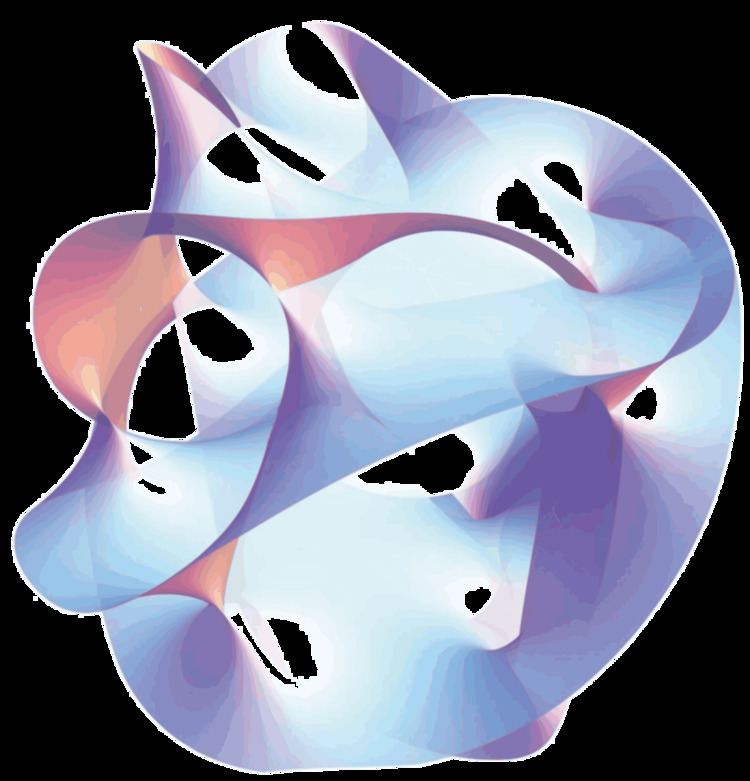 | ||
Montonen–Olive duality or electric-magnetic duality is the oldest known example of strong-weak duality or S-duality according to current terminology. It generalizes the electro-magnetic symmetry of Maxwell's equations by stating that magnetic monopoles, which are usually viewed as emergent quasiparticles that are "composite" (i.e. they are solitons or topological defects), can in fact be viewed as "elementary" quantized particles with electrons playing the reverse role of "composite" topological solitons; the viewpoints are equivalent and the situation dependant on the duality. It was later proven to hold true when dealing with a N = 4 supersymmetric Yang–Mills theory. It is named after Finnish physicist Claus Montonen and British physicist David Olive after they proposed the idea in their academic paper Magnetic monopoles as gauge particles? where they state:
Contents
There should be two "dual equivalent" field formulations of the same theory in which electric (Noether) and magnetic (topological) quantum numbers exchange roles.
S-duality is now a basic ingredient in topological quantum field theories and string theories, especially since the 1990s with the advent of the second superstring revolution. This duality is now one of several in string theory, the AdS/CFT correspondence which gives rise to the holographic principle, being viewed as amongst the most important. These dualities have played an important role in condensed matter physics, from predicting fractional charges of the electron, to the discovery of the magnetic monopole.
Electric-Magnetic duality
The idea of a close similarity between electricity and magnetism, going back to the time of André-Marie Ampère and Michael Faraday, was first made more precise with James Clerk Maxwell's formulation of his famous equations for a unified theory of electric and magnetic fields:
The symmetry between
Why should there be such symmetry between
Note that from the above if just one monopole of some charge
The subject of the magnetic monopole took a step forward in 1974 when Gerard 't Hooft and Alexander Markovich Polyakov independently constructed monopoles as not as quantized point particles, but as solitons, in a
At weak coupling, the electrically and magnetically charged objects look very different: one an electron point particle that is weakly coupled and the other a monopole soliton that is strongly coupled. The magnetic fine structure constant is roughly the reciprocal of the usual one:
In 1977 Claus Montonen and David Olive conjectured that at strong coupling the situation would be reversed: the electrically charged objects would be strongly coupled and have nonsingular cores, while the magnetically charged objects would become weakly coupled and point like. The strongly coupled theory would be equivalent to weakly coupled theory in which the basic quanta carried magnetic rather than electric charges. In subsequent work this conjecture was refined by Ed Witten and David Olive, they showed that in a supersymmetric extension of the Georgi-Glashow model, the
Mathematical formalism
In a four-dimensional Yang-Mills theory with N=4 supersymmetry, which is the case where the Montonen–Olive duality applies, one obtains a physically equivalent theory if one replaces the gauge coupling constant g by 1/g. This also involves an interchange of the electrically charged particles and magnetic monopoles. See also Seiberg duality.
In fact, there exists a larger SL(2,Z) symmetry where both g as well as theta-angle are transformed non-trivially.
The gauge coupling and theta-angle can be combined together to form one complex coupling
Since the theta-angle is periodic, there is a symmetry
The quantum mechanical theory with gauge group G (but not the classical theory, except in the case when the G is abelian) is also invariant under the symmetry
while the gauge group G is simultaneously replaced by its Langlands dual group LG and
Philosophical implications
The Montonen-Olive duality throws into question the idea that we can obtain a full theory of physics by reducing things into their "fundamental" parts. The philosophy of reductionism states that if we understand the "fundamental" or "elementary" parts of a system we can then deduce all the properties of the system as a whole. Duality says that there is no physically measurable propoerty that can deduce what is fundamental and what is not, the notion of what is elementary and what is composite is merely relative, acting as it were as a kind of gauge symmetry. This seems to favour the view of emergentism, as both the Noether charge (particle) and topological charge (soliton) have the same ontology. Several notable physicists underlined the implications of duality:
